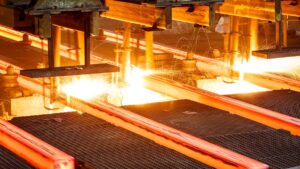Monsters of Rock: Mincor’s Kambalda nickel revival is one step closer

Pic: Getty
Mincor Resources’ (ASX:MCR) six year odyssey to return the famous Kambalda nickel district in WA to a semblance of its former glory is nearly complete.
It has trucked its first lot of nickel ore from the northern operations on the Kambalda Dome to the BHP (ASX:BHP) Nickel West concentrator.
That concentrator was first built in 1967, less than 18 months from the discovery of nickel by driller Jack Lunnon on January 28 1966 which sparked one of Australia’s most famous mining booms.
It has only been on ice a couple of times since, when nickel prices have hit their customary cyclical lows, most recently when IGO (ASX:IGO) shut the Long mine four years ago, the last operation supplying ore to the mill.
Mincor’s decision to stay faithful to Kambalda is looking like a decent one now, as low supplies and demand from EV battery makers have driven nickel prices to decade long highs in excess of US$23,000/t.
When it officially stopped mining activities in early 2016, nickel was fetching just US$7600/t.
It has since consolidated most of the historic nickel mines on the Kambalda Dome and opened the first greenfields mine in the region in decades at Cassini, near Widgiemooltha.
With stockpiles now building at the concentrator, BHP is expected to reopen the mill, which currently only dries concentrate from IGO and Western Areas (ASX:WSA).
“This is another fantastic achievement for our team as we close-in on first nickel concentrate production, which remains on track to be achieved next quarter,” Mincor MD David Southam said.
“It’s a significant moment for everyone involved with Mincor to see high-grade nickel ore being hauled from one of our mines to the Kambalda Nickel Concentrator.
“With the current nickel price substantially above the assumed price used in our DFS, we are incredibly excited to be on the cusp of production once again in Kambalda.”
This is good news for the Kambalda football team
Have you heard of the Kambalda Eagles?
When nickel hit a low back in 2016 so did the local footy team, getting hammered in just about every game and relying on players from Leonora, a round trip of 600km, to field a team.
The last time they were a serious premiership threat was in 2008, not long after nickel hit an all time high in excess of US$50,000/t in 2007.
The GFC hammered the town, and an exodus of players left them in a decade long funk which at one point included a losing streak of 49 straight games stretching over three years, regularly missing the finals in a five team league where only one club gets the early holiday.
They recently welcomed 2008 Goldfields Football League grand final coach Stan Ward back with Port Adelaide and North Melbourne great Byron Pickett in tow as his assistant.
We hope it’s the start of a turnaround story as good as Nickel West and Mincor’s.
BHP bullish on nickel
Once on the chopping block because no one wanted to take it off BHP’s hands and considered too burdensome for the South32 (ASX:S32) spinout, Nickel West is now a core business at BHP, which wants a slice of the riches expected to flow to mining companies from the energy transition.
BHP is bullish on nickel, highlighting it and fellow base metal copper as two commodities set to benefit from green demand in the years ahead in a commodity outlook.
In particular, it is positive about the outlook for class 1 nickel metal produced from nickel sulphides like those mined by Mincor in Kambalda, against laterites mined largely in south east Asia which mainly supply the stainless steel sector.
“Longer term, we believe that nickel will be a substantial beneficiary of the global electrification mega–trend and that nickel sulphides will be particularly attractive,” BHP VP market analysis and economics Huw McKay said.
“This is due to their relatively lower cost of production of battery–suitable class–1 nickel than for laterites, as well as the favourable position of integrated sulphide operations on the GHG emissions intensity curve.”
McKay said nickel stocks had moved into a heavy deficit quicker than BHP previously projected, noting that LME traded metals like nickel tend to break the linear relationship between stock levels and prices shoot up significantly once they hit critical levels.
“In this regard, it is noteworthy that even with the latest rally, nickel prices are still well short of the previous cycles peaks of around $50,000/t and $29,000/t of 2007 and 2011 respectively, while copper and iron ore (to name just two adjacent commodities) have established all–time highs over the last 12 months,” he said.
“That illustrates two things: (1) the disruptive force of the nickel pig iron [NPI] innovation on the industry’s fundamental cost base still casts a long shadow. (2) If nickel prices were to really fly–up, historical precedent indicates there is lot of headroom.”
That last line is sure to have nickel juniors in WA excited.
BHP salvages Materials sector
BHP, which since the unification of its local and British entities makes up a tenth of the ASX 200, salvaged the Aussie materials sector from an iron ore wipeout.
The Big Fella’s monster $10.7 billion dividend (US$7.6b) was enough to keep it close to the green on a day when Chinese apparatchiks pulled the strings in commodity markets.
Chinese efforts to counter “speculative” iron ore trading it has blamed for recent price rises sent Dalian iron ore futures prices close to the 10% limit down today, with an 8.6% drop marking the third trading day in a row with heavy losses.
Spot prices have been more resilient, dropping only 0.7% overnight Monday to US$148.20.
All hammered were Rio Tinto (ASX:RIO), Fortescue (ASX:FMG) and MinRes (ASX:MIN), which suspended its dividend last week after suffering an underlying post-tax half year loss of $36 million because of higher costs and discounts for its lower grade iron ore.
The Materials sector was off 0.94% at 4pm AEDT.
Monsters share prices today:
SUBSCRIBE
Get the latest breaking news and stocks straight to your inbox.
It's free. Unsubscribe whenever you want.
By proceeding, you confirm you understand that we handle personal information in accordance with our Privacy Policy.








